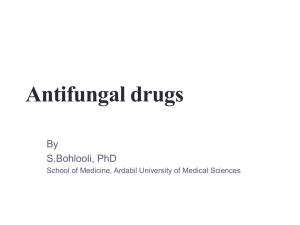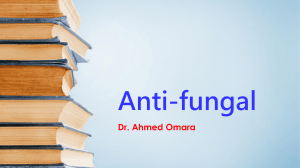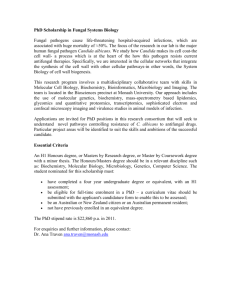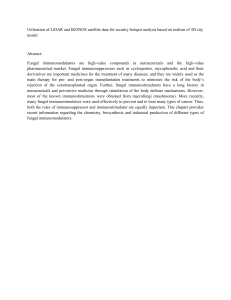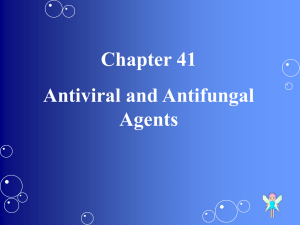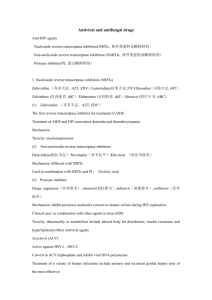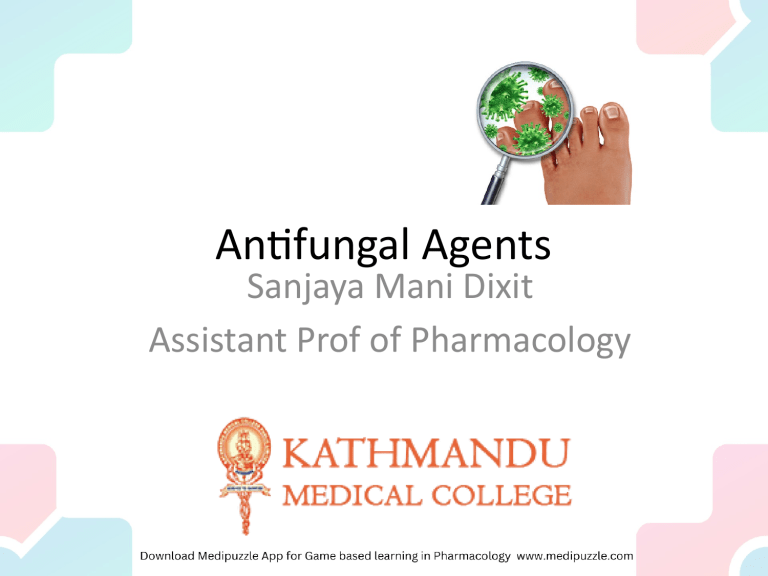
Antifungal Agents Sanjaya Mani Dixit Assistant Prof of Pharmacology Antifungal Agents Fluconazole Clotrimazole Ketoconazole Itraconazole Terbinafine Tolnaftate Amphotericin B Nystatin Micafungin Caspofungin Griseofulvin Flucytosine Contents • • • • • • Fungal Infections Fungal infections in Nepal Antifungal Drugs Mechanisms involved Classification of Antifungal Drugs Individual Drugs and Classes Fungal Infections • Human fungal infections have increased dramatically in incidence and severity in recent years. • A large extent of fungal infections are iatrogenic. • This is mainly due to: – – – – – advances in surgery, indwelling catheters and implants cancer treatment, increases in use of broad-spectrum antimicrobials and the HIV epidemic. Fungal Infections • Major Types of Mycoses – superficial – cutaneous – subcutaneous – systemic – Opportunistic Fungal Infections • Symptoms vary from cosmetic to life threatening. • Fungal infections are usually more difficult to treat than bacterial infections, because: – fungal organisms grow slowly and – fungal infections often occur in tissues that are poorly penetrated by antimicrobial agents (e.g., devitalized or avascular tissues). • Therapy of fungal infections usually requires prolonged treatment. Burden of Serious Fungal Infections in Nepal -2012 Study • About 1.94% of the Nepalese population is estimated to suffer from a serious fungal infection annually • The most serious fungal infections occur in HIV/AIDS and immunocompromised patients. • Both pathogenic and allergenic fungi including Aspergillus species are common in the air in Kathmandu valley. • Fungal keratitis is the most prevalent fungal infection in Nepal. • There is also a high burden of ABPA and CPA. Antifungal Agents Classification of Antifungals Based on Site of Action Systemic antifungal agents: Amphotericin-B, Flucytosine, Imidazoles –Ketaconazole Triazoles – Fluconazole, Itraconazole Topical antifungal agents: Imidazole and Triazoles --Clotrimazole, Miconazole, Polyenes --Nystatin Tolnaftate, Naftifine Classification of Antifungals Based on Mechanism of Action Alter cell membrane permeability: Azoles Terbinafine Polyenes Block nucleic acid synthesis: Flucytosine Disrupt microtubule function: Griseofulvin Nystatin Targets of Antifungal drugs • Despite differences in the composition of the cell membrane and the presence of the cell wall, fungi are metabolically similar to mammalian cells and offer few pathogen- specific targets. • Azole and polyene antifungal agents exert their antifungal effects by targeting ergosterol- the principal cell membrane sterol of many pathogenic fungi. Timeline of Systemic Antifungal Agents • • • • • Introduction of Amphotericin B - deoxycholate in 1958 Standard treatment for serious fungal infections Infusion-related adverse effects and dose-limiting nephrotoxicity Introduction of fluconazole in 1990, excellent oral bioavailability Fluconazole - one of the most widely prescribed antifungal agents for mucosal and systemic yeast infections. Timeline of Systemic Antifungal Agents • Fluconazole --lack of activity against opportunistic molds (ie, Aspergillus, Mucorales, and Fusarium species) and intrinsic resistance among some Candida species. • Itraconazole (1992) improved activity against endemic fungi and Aspergillus species, but the oral dosing formulations were plagued by erratic absorption (capsules) or adverse gastrointestinal (GI) effect. • Introduction of broader-spectrum triazoles voriconazole (2002) and posaconazole (2006) transformed the management of invasive mold infections in severely immunocompromised patients. • Unfortunately, the broader spectrum of activity with triazole antifungal agents often comes at the expense of increased pharmacokinetic variability and risk of drug interactions. Echinocandins • Echinocandins are semisynthetic lipopeptides that inhibit synthesis of β1,3-d-glucan in susceptible fungi, leading to damage of the fungal cell wall. • Because a glucan-rich cell wall is a target not found in mammalian cells, these agents were predicted to be effective antifungal agents with very little collateral toxicity in mammalian cells—a prediction that has been proven true in clinical trials of patients with invasive candidiasis and aspergillosis. • However, echinocandins still lack activity against some common opportunistic yeasts (Cryptococcus species) and less common molds (ie, Fusarium, Scedosporium, and Mucorales) that often develop as breakthrough infections in severely immuno-compromised patients. Timeline of Systemic Antifungal Agents The search continues No single antifungal agent is appropriate for all patients for a given mycosis because of : • patient-specific comorbid conditions, • hypersensitivities, • risk of drug interactions, • immunosuppression, • site of infection, and • risk of infection with more intrinsically antifungal-resistant pathogens. Azoles • Inhibit 14α-demethylase (lanosterol demethylase), a fungal cytochrome P450 (CYP)–dependent enzyme • Deplete cell membrane ergosterol, • Impair membrane fluidity, and • Lead to accumulation of toxic 14α-methylated sterols, • Resulting in growth arrest and • Eventual fungal cell death. • However, this inhibition is not entirely selective to fungi; indeed, collateral inhibition of human CYP enzymes by azoles is often responsible for pharmacokinetic drug-drug interactions. Allylamine-Terbinafine • The allylamine, terbinafine inhibits ergosterol biosynthesis by inhibiting squalene monoxygenase —an enzyme in fungi responsible for conversion of squalene to squalene epoxide, a precursor to lanosterol in the ergosterol synthesis pathway. • Although allylamines do not seem to have the same collateral effects on human CYP enzymes as azole antifungal agents, drugs such as rifampin that strongly induce CYP metabolism in mammals will increase the metabolism of terbinafine. • Once taken orally, terbinafine concentrates in the skin and nail beds and has relatively low bloodstream concentrations. • Consequently, its use as a systemic antifungal agent is primarily restricted to the treatment of onychomycosis and cutaneous fungal infections. Amphotericin B • The broad-spectrum polyene amphotericin B targets the fungal cell membrane. • Amphotericin B directly binds to ergosterol, forming complexes that intercalate the cell membrane, thereby resulting in pore formation and leakage of intracellular contents. • Amphotericin B has greater affinity for ergosterol-rich fungal cell membranes vs cholesterol-rich mammalian cell membranes; however, this specificity may be lost when the drug accumulates to high concentrations in organs such as the kidney, where the drug causes direct damage to distal tubular membranes. Amphotericin B • Consequently, nephrotoxicity is a common dose-limiting adverse effect of amphotericin B therapy. • Amphotericin B also directly stimulates release of proinflammatory cytokines by mononuclear phagocytic cells, often resulting in fever, rigors, and chills during drug infusion. • This infusion reaction can be attenuated to varying degrees by reformulation of amphotericin B into lipid carriers. • However, the principal advantage of lipid amphotericin B formulations are their reduced distribution of amphotericin B to the kidneys, which reduces but does not eliminate the nephrotoxicity of amphotericin B. Different Fungal infections Sporotrichosis Sporotrichosis Sporothrix schenckii, found in vegetation. Infection commonly occurs when the skin is broken while handling plant materials such as rosebushes, or dirt. Cryptococcosis Cryptococcus neoformans. It is usually found in soil. If you breathe it in, it infects your lungs. The infection may go away on its own, remain in the lungs only, or spread throughout the body (disseminate). Blastomycosis is an infection caused by breathing in the Blastomyces dermatitidis fungus. The fungus is found in wood and soil. The disease may affect the skin, bones and joints, and other areas. Different Fungal infections Valley fever is an infection that occurs when the spores of the fungus Coccidioides immitis enter your body through the lungs. Tinea versicolor is caused by Pityrosporum ovale, a fungus normally found on human skin that only causes a problem in certain settings. The condition is most common in adolescent boys and young adult men. It typically occurs in hot climates. Histoplasmosis is an infection that occurs from breathing in the spores of the fungus Histoplasma capsulatum. Soil that contains bird or bat droppings may have larger amounts of this fungus AMPHOTERICIN B Polyene anti-fungal agent Amphotericin A and B are antifungal antibiotics produced by Streptomyces nodosus. Amphotericin A is not in clinical use. Amp B is insoluble in water, but is given IV in diff forms: 1. C-AMB Colloidal Amp. With deoxycholate 2. AMBD Lipid formulations for IV infusion Amp B colloidal dispersion 3. ABLC Amphotericin B lipid complex AMPHOTERICIN B M/A • Amphotericin B is selective in its fungicidal effect. • It binds to Ergosterol, a cell membrane sterol, found in the cell membrane of fungi [bacteria and human –cholesterol]. • Increases the permeability of the cell by forming amphotericin Bassociated pores in the cell membrane • Leakage of intracellular ions and macromolecules [K+] • Oxidative damage to fungal cells • Fungistatic or Fungicidal depending on the organism and drug concentration Clinical Use • Owing to its broad spectrum of activity and fungicidal action, amphotericin B remains the drug of choice for nearly all life-threatening mycotic infections. • It is often used as the initial induction regimen for serious fungal infections and is then replaced by one of the newer azole drugs. Such induction therapy is especially important for immunosuppressed patients and those with – severe fungal pneumonia, – cryptococcal meningitis with altered mental status, or – sepsis syndrome due to fungal infection. Clinical Use • Broad spectrum activity: • For mucormycosis, invasive aspergillosis, extracutaneous sporotrichosis, cryptococcosis • In blastomycosis, histoplasmosis, coccidiomycosis, immunocompromised host or involving CNS • Candidiasis: bones, heart, CNS, urinary, esophagus, peritoneum & disseminated disease • In other antimicrobial agents failure (selected cases) • As prophylactic in AIDs, cryptococcosis • For cutaneous candida infection (topical) • Oral use to prevent colonization of intestinal flora by candida. Mucormycosis is a fungal infection of the sinuses, brain, or lungs that occurs in some people with a weakened immune system. Adverse Effects • Highly toxic drug (intravenously) • Headache, fever, dyspnea, malaise tachycardia, phlebitis, gut distress malaise (symptomatic treatment) • Nephrotoxicity: Renal acidosis, potassium& magnesium ion depletion • Azotemia-80% cases [infuse 1L of N/S before drug administration] • Hypochromic normochromic anemia , mild leukopenia • Anaphylactic reactions, rashes, diplopia, myalgia, convulsion, peripheral neuritis AMPHOTERICIN B • Although resistance to amphotericin B among Candida strains remains rare, there are recent reports of increasing MICs to amphotericin B among C. krusei and C. glabrata isolates. • Most clinicians use an MIC of >1.0 mcg/mL to indicate resistance to amphotericin B. • Defects in the ERG3 gene involved in erogosterol biosynthesis lead to accumulation of other sterols in the fungal membrance. • Consequently, polyene-resistant Candida and Cryptococcus isolates have relatively low ergosterol content, compared with that of polyene-susceptible isolates. • Resistance to amphotericin B may also be mediated by increased catalase activity, with decreasing susceptibility to oxidative damage. Nystatin • Polyene anti-fungal agent • Not absorbed orally M/A Like Amphotericin B, Ergosterol synthesis Inhibitor • For superficial mycosis: skin, Oral, gut and vaginal candidiasis. C/I parenterally (Highly Toxic) Flucytosine • 5-fluorocytosine, 5-FC • Fluorinated Pyrimidine antimetabolite related to the anti-cancer drug 5- fluorouracil (5-FC). M/A • Flucytosine is taken up by fungal cells via the enzyme membrane permease. • It is converted intracellularly first to 5-FU and then to 5fluorodeoxyuridine monophosphate (F-dUMP) and fluorouridine triphosphate (FUTP), which inhibit DNA and RNA synthesis, respectively. • Human cells are unable to convert the parent drug to its active metabolites so selective toxicity occur. • Synergistic activity with amphotericin-B. Flucytosine Clinical Uses • Narrow anti-fungal spectrum • For Cryptococcus and C. albicans with Amphotericin-B. S/Es • Prolonged & high dose flucytosine cause – reversible bone marrow depression , – alopecia, and – liver dysfunction Anorexia, Nausea, Vomitting and Diarrhoea Skin Rashes Has narrow therapeutic window, with an increased risk of toxicity at higher drug levels and resistance developing rapidly at sub-therapeutic concentrations. Flucytosine Resistance • Some yeast strains are intrinsically resistant to flucytosine because of impaired cellular uptake secondary to a mutation in cytosine permease. • On the other hand, acquired resistance results from defects in flucytosine metabolism through mutations in cytosine deaminase or uracil phosphoribosyl transferase. • The prevalence of primary resistance to flucytosine remains low – 1%–2% among Candida isolates – < 2% among C. neoformans isolates Azole Antifungal Agents • Azoles are synthetic compounds that can be classified as either imidazoles or triazoles derivatives. • Ketoconazole Fluconazole • Itraconazole Clotrimazole • Miconazole • Oral bioavailability variable (normal pH) • Fluconazole: is absorbed orally > others & has highest therapeutic index among azoles. It therefore is preferred agent for oral use. It is the azole of choice in the treatment and secondary prophylaxis of cryptococcal meningitis. Mechanism Of Action • Inhibition of fungal cytochrome P450 enzymes • Inhibit the synthesis of ergosterol • Interfere with fungal cell membrane permeability • Selective action--The specificity of azole drugs results from their greater affinity for fungal than for human cytochrome P450 enzymes. Imidazoles exhibit a lesser degree of specificity than the triazoles, accounting for their higher incidence of drug interactions and side effects. Uses For Superficial candida infection • Oropharyngeal: fluconazole, ketoconazole (orally); nystatin, clotrimazole (topically) • Cutaneous: itraconazole, terbinafine, griseofulvin (orally); triazoles, ciclopirox, haloprogin, naftifin, etc (topically) • Vulvovaginitis: fluconazole (orally); nystatin, clotrimazole, miconazole (topically) Adverse effects: Relatively non-toxic • GI upset (most common) • Abnormalities in liver enzymes and, • very rarely clinical hepatitis. Pulse dosing • Pulse or intermittent dosing with the azoles is effective in onychomycosis as continuous dosing, because drug persists in the nails for several months • Treat for one week, followed by three weeks without drug Azoles Resistance • Azoles exert their action by inhibiting the C14alpha demethylation of lanosterol in fungi, which interferes with the synthesis of ergosterol in the fungal cell membrane. • Azoles differ in their affinities to their target, which may account for differences in their spectrum of activity • In addition, variations in the structure of azoles are thought to be responsible for the cross-resistance patterns among Candida species. ITRACONAZOLE • A very important drug even to be considered for its potential drug interactions. • Available as a capsule and two solution formulations, one for oral and one for I/V administration. ITRACONAZOLE: USES • Azole of choice for treatment of disease due to the dimorphic fungi• histoplasma, • blastomyces, and • sporothrix. • Has activity against aspergillus species, but it has been replaced by Voriconazole as the azole of choice for aspergillosis. • Used extensively in the treatment of dermatophytoses and onychomycosis. • Dose: 100–400 mg/d • Voriconazole -The newest triazole available in IV and oral formulations. Dose: 400 mg/d ITRACONAZOLE: S/Es • Hepatotoxicity; rarely hepatic failure and death [Discontinue the drug and assess LFT.] • A dose-dependent inotropic effect may precipitate CHF in patients with impaired ventricular function. • GI distress less common at small dose (up to 200 mg). • OTHERS: • Nausea, vomiting, hypokalemia, increased serumaminotransferases, rash [occasional discontinuation] • High Doses > 300 mg BID • Adrenal insufficiency, lower limb edema, hypertension or rhabdomyolysis. • Phlebitis at injection site. Ketoconazole • Ketoconazole was the first oral azole introduced into clinical use. Drug of choice in following conditions: • Non-meningeal blastomycosis, • Histo-blasmomycosis, • Coccidoidomycosis & • Chronic mucocutaneous candidiasis • In griseofulvin resistant ring worm of skin and taenia versicolor • A/Es • Menstrual irregularity, Gynecomastia • Decreased libido and Azoospermia • Hypertension & salt retention [Elevated mineralocorticoid] • Teratogenicity CLOTRIMAZOLE • Topical Azole • Absorption of clotrimazole is less than 0.5% after application to the intact skin; from the vagina, it is 3% to 10%. • Fungicidal concentrations remain in the vagina for as long as 3 d. • Small amount absorbed is metabolized in the liver and excreted in bile. CLOTRIMAZOLE THERAPEUTIC USES: • Available as a 1% cream, lotion, and solution, 1% or 2% vaginal cream or vaginal tablets of 100, 200, or 500 mg, and 10 mg troches. • On the skin, applications are made BID. CLOTRIMAZOLE A/E: Skin--stinging sensation, erythema, edema, vesication, desquamation, pruritus, and urticaria. Applied to the vagina, a mild burning sensation, and rarely of lower abdominal cramps, a slight increase in urinary frequency, or skin rash. Occasionally, the sexual partner may experience penile or urethral irritation. By the oral route; can cause GI irritation. In patients using troches, the incidence of this side effect is about 5%. Griseofulvin • Griseofulvin is a very insoluble fungistatic drug • Oral absorption depends on physical state of the drug, better absorption when taken with high fat foods • Well distributed • Biliary excretion M/A: Fungistatic • Interferes with microtubule function • Inhibits the synthesis and polymerization of nucleic acids It is deposited in newly forming skin where it binds to keratin, protecting the skin from new infection. Griseofulvin Uses For dermatophytoses of the skin, hairs, and nails Side Effects: • Headache, • Mental confusion, • Gut distress, • Photosensitivity and • Changes in liver enzyme function • Enhances coumarin metabolism TERBINAFINE • A synthetic allylamine. • A systemic antifungal (Oral) for systemic infections; however 1% cream is also available for topical use. • Acts the interfering the synthesis of Sterols (LANOSTEROL) in sensitive fungi. • Like Griseofulvin, it is keratophilic, but unlike griseofulvin, it is fungicidal. • Pregnancy Category: B; unsafe. TERBINAFINE MECHANISM: • Interferes with synthesis of Lanosterol by binding and inhibiting to squalene epoxidase of sensitive fungi accumulation of squalene death. • Squalene is a sterol but it is toxic to fungi. TERBINAFINE PHARMACOKINETICS: • Good oral absorption but extensive 1st pass metabolism in liver bioavailability ~40%. • ~99% drug bound to plasma protein; accumulates well in skin, nails and fats. • CSF concentrations are about 10 % • Initial T1/2 of ~12 h increases significantly to almost 200-400 h at SS. • Not recommended to patients with azotemia and *hepatic failure *increased concentration. TERBINAFINE THERAPEUTIC USES: Nail Onchomycosis: 250-mg tablet OD, is at least as effective as 200 mg OD of itraconazole, and slightly more effective than pulse itraconazole therapy. Duration of treatment varies with the site being treated but typically is 3 months. Ringworm: Ringworm elsewhere in body responds well to 250 mg OD. No pediatric dose is available. Contraindicated in pregnancy; systemic therapy onychomycosis postponed until pregnancy is complete. for TERBINAFINE ADVERSE EFFECTS: • Well tolerated • Low incidence of GI distress, headache, or rash. • Rarely, hepatotoxicity, severe neutropenia, Stevens-Johnson syndrome, or toxic epidermal necrolysis. Newer Antifungal Agents Isavuconazole • Isavuconazonium sulfate, is a water-soluble triazole prodrug that can be administered both orally and intravenously. • It is broken down by plasma esterases to the active component, isavuconazole. • Its structure confers activity against some pathogens resistant to other azoles, including itraconazole, voriconazole, and posaconazole. • Isavuconazole appears to be highly active against all Candida species including species such as C. glabrata and C. krusei, which are inherently less susceptible to other azoles such as fluconazole. • Isavuconazole also has an excellent activity against Cryptococcus gattii and C. neoformans. Lulliconazole • Luliconazole is an imidazole antifungal agent that has been shown to have potent activity against a variety of fungi, especially dermatophytes. • Luliconazole is the R-enantiomer, and has more potent antifungal activity than lanoconazole, which is a racemic mixture. • Luliconazole, although belonging to the azole group, has strong fungicidal activity against Trichophyton spp., similar to that of terbinafine. This is possibly attributable to a combination of strong in vitro antifungal activity and favorable pharmacokinetic properties in the skin. • Luliconazole 1% cream was approved in Japan in 2005 for the treatment of tinea infections. • Further studies to evaluate its efficacy in onychomycosis are underway. Novamycin • A potent synthetic antimicrobial peptide (AMP) - poly-Arginine based cationic peptide. • It acts through membrane perturbation and lysis; this mode of action rapidly killing both non-metabolising and metabolically active fungi. • This mechanism of action minimises or negates the risk of acquired drug resistance. A mechanism of action that is specific only to fungal cells, is not toxic to human cells. • A rapidly acting fungicidal peptide that has demonstrated superiority over existing antifungal classes in preclinical testing (with a placebo like safety profile) for a number of fungal infections. • Treatment of aspergillosis, candidiasis Novexatin • Novexatin is a novel, potent, synthetic antimicrobial peptide (AMP) , cyclic arginine-based heptamer. • Novexatin is rapidly fungicidal through a membranolytic mode of action that targets both non-metabolising and metabolically active nail fungal pathogens. This includes both dermatophyte and non-dermatophyte fungi associated with onychomycosis. • Novexatin remains stable and bioavailable within the nail for more than 12 months post-application. • Phase I and IIa clinical studies have demonstrated that NP213 is safe, welltolerated and effective in resolving toenail infections following just one month of daily application (currently available topical treatments require up to 52 weeks of treatment). • It is applied topically. It is the first treatment for fungal nail infections to address both the underlying cause by killing the fungi and to rapidly improve the nail's appearance. Candida vaccine-Oral • Enolase 1 (Eno1p) of Candida albicans is an immunodominant antigen. • To develop a novel type of oral vaccine against candidiasis, Saccharomyces cerevisiae cells that display the Eno1p antigen on their surfaces were generated. • Oral delivery of the engineered S. cerevisiae cells prolonged survival rate of mice that were subsequently challenged with C. albicans . • Together, C. albicans and Candida glabrata are responsible for 70–80% of Candidainfections in patients with candidiasis or candidemia. • Pharmacotherapy of candidiasis often involves the administration of caspofungin, micafungin, anidulafungin and amphotericin B. However, mutants of Candida with reduced susceptibility to these drugs have emerged (Rodloff et al. , 2011 ). Amphotericin B -Nanoparticles BENZOIC ACID & SALICYLIC ACID Whitfield's ointment: • An ointment containing benzoic and salicylic acids. • Combines the fungistatic action of benzoate with the keratolytic action of salicylate. • Contains BA and SA in a ratio of 2:1 (usually 6% to 3%) and used mainly in the treatment of tinea pedis. • Since BA is only fungistatic, eradication of the infection occurs only after the infected stratum corneum is shed, and continuous medication is required for several weeks to months, scrapping accelereted by SA. • Also sometimes used to treat tinea capitis. • Mild irritation may occur at the site of application. Trusted by 10K + Students www.medipuzzle.com That’s All ENJOY 67
